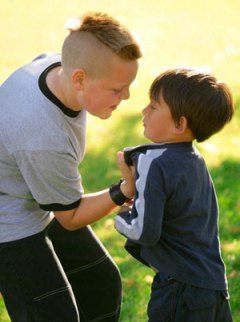Practical experience
None of this makes me an expert at surviving a shooting; it just lets you know that I’ve actually experienced some of the situations on which I regularly give advice. In my late teens and early 20’s I had trained to survive similar situations, but never believed I would have any real-world need to deal with this stuff. When I worked with and trained law enforcement officers at “Mean Street” in the early 1990s, we had the opportunity to use paintball guns and “simunitions” that made it easier to envision real gunfire while training. Mean Street was a paintball center featuring an urban setting complete with cars, a truck, a bus and two houses and a duplex that made up a small neighborhood. It was surrounded on 3 sides with embankments and it had a tree line—a forest about 100 feet away that was perfect for snipers. The owner was ex-special forces and I brought my experience to the party as well, teaching both in a small dojo in the back of the office building and often bringing the training out onto Mean Street. At the time, it was as real as you could get. When the day ended, everyone knew that they would go home with nothing more than a couple of welts and a bruised ego. When shots are fired in a real-life situation, you only have seconds to react and enter survival mode. Here’s what to do:
Be alert and awareBefore anything happens, stay alert, and always be aware of your surroundings (keep an eye out for suspicious looking individuals, situations that don’t “feel” right, etc.). Report any suspicious activity. Let the authorities determine if any action needs to be taken. If a shooting does occur in your immediate area, stay calm. I know that this sounds easier than it is, but through my years I’ve encountered countless emergency situations spanning from self-defense scenarios to first-aid incidents.
Remember to take a deep breath and tell yourself. “Okay…here we go”. If you panic and give into fear, you may be immobilized. Whatever happens, don’t give up without a fight.
Know your location
.jpg)
Know where the emergency exits are in your location. If there is shooting in your area and you are unable to get to an exit, look for a place to hide (closet, under desk, etc.). Turn out the light so the room appears empty. Ask your supervisor or school officials if you have a “lockdown” strategy in place. If not, create and implement one.
Get away
If the shooter is within your field of vision, but at a distance of 25 to 30 feet away (or greater) you should run. When running, stay low and move in a serpentine fashion/zig-zag motion. A moving target is difficult to hit—even for a trained professional or experienced firearm handler. If you are inside a building and don’t have an open area in which to run (parking lot, etc.), try to lock or barricade yourself in a room. Escape out a window if possible. If escape is impossible, hide.
Find cover
.jpg)
If the shooter is in your immediate area, find cover fast (desk, furniture, or anything that can provide protection between you and the shooter). If you have no cover, drop to the ground and cover your head with your hands. If the shooter is determined to shoot you (and you are unable to find cover), fight back. Hit them with a heavy object and/or throw things at them to distract and/or stun them. If you can, target the hand that is holding the weapon—you may be able to disarm them.
Formal training is no guarantee
Formal training in weapons defense and survival is not a guarantee that you will come out of a school or workplace shooting in one piece As long as the training you receive is based on reality and not a James Bond movie; you will increase your chances of survival. Many times I’ve been training in gun disarms and had someone say, “I would have been able to shoot you just now”. Maybe that’s true. But if an assailant is determined to shoot you, your choices are limited: run, hide, fight, or be shot. If I can’t run or hide, I’m not going to sit there and make it easy for the shooter.
.JPG)
.jpg)
.jpg)
.jpg)
.JPG)
.JPG)
.jpg)





.JPG)
.JPG)


